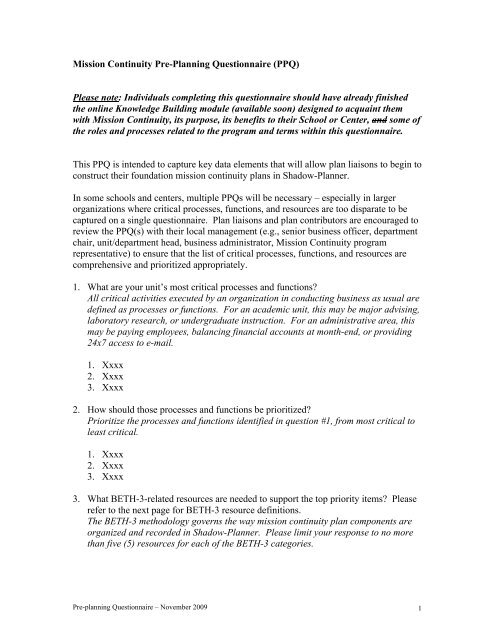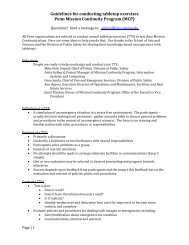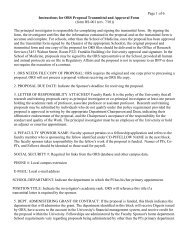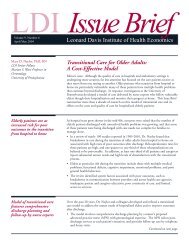Pre-Planning Questionnaire
Pre-Planning Questionnaire
Pre-Planning Questionnaire
You also want an ePaper? Increase the reach of your titles
YUMPU automatically turns print PDFs into web optimized ePapers that Google loves.
Mission Continuity <strong>Pre</strong>-<strong>Planning</strong> <strong>Questionnaire</strong> (PPQ)<br />
Please note: Individuals completing this questionnaire should have already finished<br />
the online Knowledge Building module (available soon) designed to acquaint them<br />
with Mission Continuity, its purpose, its benefits to their School or Center, and some of<br />
the roles and processes related to the program and terms within this questionnaire.<br />
This PPQ is intended to capture key data elements that will allow plan liaisons to begin to<br />
construct their foundation mission continuity plans in Shadow-Planner.<br />
In some schools and centers, multiple PPQs will be necessary – especially in larger<br />
organizations where critical processes, functions, and resources are too disparate to be<br />
captured on a single questionnaire. Plan liaisons and plan contributors are encouraged to<br />
review the PPQ(s) with their local management (e.g., senior business officer, department<br />
chair, unit/department head, business administrator, Mission Continuity program<br />
representative) to ensure that the list of critical processes, functions, and resources are<br />
comprehensive and prioritized appropriately.<br />
1. What are your unit’s most critical processes and functions<br />
All critical activities executed by an organization in conducting business as usual are<br />
defined as processes or functions. For an academic unit, this may be major advising,<br />
laboratory research, or undergraduate instruction. For an administrative area, this<br />
may be paying employees, balancing financial accounts at month-end, or providing<br />
24x7 access to e-mail.<br />
1. Xxxx<br />
2. Xxxx<br />
3. Xxxx<br />
2. How should those processes and functions be prioritized<br />
Prioritize the processes and functions identified in question #1, from most critical to<br />
least critical.<br />
1. Xxxx<br />
2. Xxxx<br />
3. Xxxx<br />
3. What BETH-3-related resources are needed to support the top priority items Please<br />
refer to the next page for BETH-3 resource definitions.<br />
The BETH-3 methodology governs the way mission continuity plan components are<br />
organized and recorded in Shadow-Planner. Please limit your response to no more<br />
than five (5) resources for each of the BETH-3 categories.<br />
<strong>Pre</strong>-planning <strong>Questionnaire</strong> – November 2009 1
Building:<br />
Basic information about buildings/facilities that is essential to the<br />
resumption/continuation of your unit’s most critical processes and functions.<br />
Examples include a research laboratory or classroom in a School (Biochemistry<br />
Laboratory in the School of Medicine’s John Morgan building), or a computer room<br />
in a specific building that houses critical computing equipment (the Data Center in<br />
3401 Walnut Street). <br />
1. Xxxx<br />
2. Xxxx<br />
3. Xxxx<br />
4. Xxxx<br />
5. Xxxx<br />
Equipment:<br />
Necessary equipment and supplies that are essential to the resumption/continuation<br />
of your unit’s most critical processes and functions. Examples include an electron<br />
microscope in a specific research laboratory, or back-up power generator<br />
requirements for important computer systems.<br />
1. Xxxx<br />
2. Xxxx<br />
3. Xxxx<br />
4. Xxxx<br />
5. Xxxx<br />
Technology:<br />
Key technology and systems that are essential to the resumption/continuation of your<br />
unit’s most critical processes and functions. Examples include a Blackboard site for<br />
a class, or enterprise-wide technology like the University’s Payroll/Personnel system,<br />
PennNet, or e-mail.<br />
1. Xxxx<br />
2. Xxxx<br />
3. Xxxx<br />
4. Xxxx<br />
5. Xxxx<br />
Human resources (people):<br />
Key personnel or job functions that are essential to the resumption/continuation of<br />
your unit’s most critical processes and functions. Examples include a certain lab<br />
assistant with critical knowledge of a specific experiment, or a computer technician<br />
skilled in the recovery processes necessary to bring back-up servers online and make<br />
them accessible to users.<br />
<strong>Pre</strong>-planning <strong>Questionnaire</strong> – November 2009 2
1. Xxxx<br />
2. Xxxx<br />
3. Xxxx<br />
4. Xxxx<br />
5. Xxxx<br />
3 rd Party/Vendor:<br />
Key third-party partners or suppliers that are essential to the<br />
resumption/continuation of your unit’s most critical processes and functions.<br />
Examples include an external vendor that supplies specific laboratory animals with a<br />
special food diet or an internal administrative center, such as Information Systems<br />
and Computing, that supplies an organization’s primary e-mail system.<br />
1. Xxxx<br />
2. Xxxx<br />
3. Xxxx<br />
4. Xxxx<br />
5. Xxxx<br />
4. How would your answers to the other questions change if there was an interruption in<br />
service that lasted one hour, one day, one week, 2-4 weeks, 5 weeks or longer Is<br />
time important in restoring your critical processes and functions<br />
Consider both elapsed downtime (e.g., a laboratory monitoring process cannot be<br />
unavailable more than one hour -or- this is the consequence if we are without e-mail<br />
for a week) and time of year issues (e.g., an accounting function must be available on<br />
the first of each month for reconciliation purposes -or- admissions decisions must be<br />
released on a certain date).<br />
5. Knowing what your critical functions and processes are, what do you plan to do in the<br />
event of a crisis concerning each of the BETH-3 items (buildings, equipment,<br />
technology, human resources, and third-parties) For example, what alternate<br />
facilities will you need should your critical facilities become unavailable<br />
6. Who are the responsible people for carrying out these plans<br />
7. What can you do now to prepare for a crisis, even before you start to use your Action<br />
Plans<br />
<strong>Pre</strong>-planning <strong>Questionnaire</strong> – November 2009 3

















